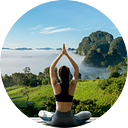When your workout routine starts feeling monotonous, a breath of fresh air can come from trying a new type of fitness class. Venturing into Pilates classes can be a fantastic way to invigorate your fitness journey, whether you’re participating in mat-based sessions or utilizing the Pilates reformer apparatus.
Pilates offers remarkable flexibility, extending beyond gym and studio settings. It’s adaptable to at-home workouts or virtual platforms, making it an accessible option for a wide range of preferences.
No matter how you engage with Pilates, this practice has the potential to revolutionize your workout experience, regardless of your fitness background.
Curious to learn more? Here’s a comprehensive guide for Pilates newcomers, equipping you to make the most of your initial class.
Pilates Unveiled: A Primer
Pilates stands as a low-impact exercise form, focusing on bolstering muscles while enhancing posture alignment and flexibility. Typically lasting 45 minutes to an hour, Pilates workouts are characterized by slow, meticulous movements and breath control.
Although Pilates zeros in on the core, it isn’t restricted to specific body parts. Gabriela Herbert, founder of Black Girl Pilates, clarifies that the core encompasses the entire trunk, comprising abdominals, hips, inner and outer thighs, and back. While the core forms the crux, Pilates often engages areas such as arms, glutes, and lower legs, offering a comprehensive full-body workout.
Unlocking the Benefits
The benefits of Pilates are abundant and diverse. Herbert attests that Pilates acts as a holistic exercise method enhancing overall performance. It builds and stabilizes the core, a foundation for efficient movement, improved posture, flexibility, and mobility.
Furthermore, Pilates is functional; a study in the Journal of Exercise Rehabilitation revealed its effectiveness in enhancing balance, stability, and mobility. Muscle gains are evident, especially in endurance, supported by a Journal of Strength & Conditioning Research study highlighting significant enhancements in core strength, hamstring flexibility, and upper-body muscular endurance.
Mental health isn’t left untouched, as a meta-analysis of Pilates studies demonstrated reductions in symptoms of depression, anxiety, and fatigue while increasing energy levels.
Prepping for Your Pilates Journey
1. Mat Classes for Beginners: These are a great starting point. Understanding Pilates fundamentals on the mat assists in comprehending body support without external resistance. Look for “classic mat” classes, which establish essential exercises.
2. Pilates Equipment: While mat-based classes are foundational, familiarize yourself with equipment like the Pilates reformer, Wunda, Cadillac, and Magic Circle. If you’re a beginner, notify your instructor for guidance.
3. Complementary to Yoga: Pilates and yoga share similarities but possess distinct focuses. Pilates targets strength and stability, while yoga emphasizes flexibility. Acknowledge these differences for a well-rounded routine.
4. Common Exercises: A host of established Pilates exercises, like The Hundred, Roll-Up, and Leg Circles, are prevalent in beginner classes. As you progress, your practice evolves with additional challenges.
5. Virtual Pilates: If you’re more comfortable with at-home workouts, consider virtual classes. These offer a grounded introduction and could lead to in-person classes later.
6. Embrace the Burn: Pilates might not involve high-intensity moves, yet its micro-movements lead to intense muscle engagement. This can result in a unique, subtle soreness and DOMS.
7. Embrace the Lingo: Pilates has its own terminology, like “powerhouse,” “peel through your spine,” and more. Familiarize yourself with these phrases to enhance your practice.
8. Appropriate Attire: Opt for body-hugging attire to aid instructors in observing your movements. Consider socks with rubber detailing to prevent slipping.
9. Balanced Routine: Integrate Pilates within a well-rounded workout regimen. Cross-training and complementary exercises maintain a holistic approach to fitness.
10. Mindful Progression: Start gradually to prevent injury. Seek out beginner classes and consider private lessons for guidance. Prioritize proper warm-ups and listen to your body.
Remember, Pilates is a journey, not a destination. Approach it with curiosity, patience, and a commitment to your well-being.
